|
|
Opel Adam
|
 |
|
|
Debut: 2012
Maker: Opel
Predecessor:
No
|
|
|
|
| Published
on 13
Nov
2012 |
All rights reserved.
|
|
|
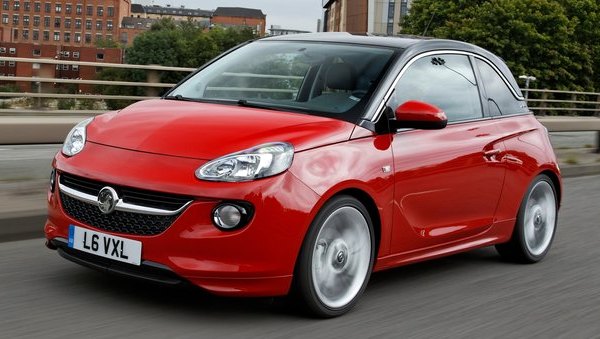
|
Mini started the trend of
fashionable, highly customizable small cars that was soon followed by
Fiat 500 and Citroen DS3. These niche models are far more desirable
than conventional
small cars, and their countless options guarantee good profit margins.
Seeing their success, now even the traditionally conservative Opel also
joins the camp. Opel Adam – named after the founder of Opel – sits
under Corsa to be the smallest car manufactured by Opel itself. It is
derived from a shortened Corsa platform, but it gets a
very different packaging so that you won't see the slightest traces of
Corsa. The result is remarkably fresh to eyes.
Unlike Mini or Fiat, Opel does not have any iconic models in its 150
years history. As there is no heritage to draw on, its styling has to
start from a clean sheet. Fortunately, Rüsselsheim has done a
great job to create a head-turning design. It looks cute, elegant and
distinctive
enough. More advant-garde than its retro rivals, and prettier than
Citroen DS3 or Audi A1. There are some traces of the 1996 Ford Ka in its side
profile and clamshell tailgate, but otherwise the car is original. Its
interrupted C-pillar is certainly a trademark feature. Ditto the easily
recognizable face with a prominent grille and high-mounted fog lamps.
Most successful is that it looks cute yet sophisticated, something very
difficult to achieve.
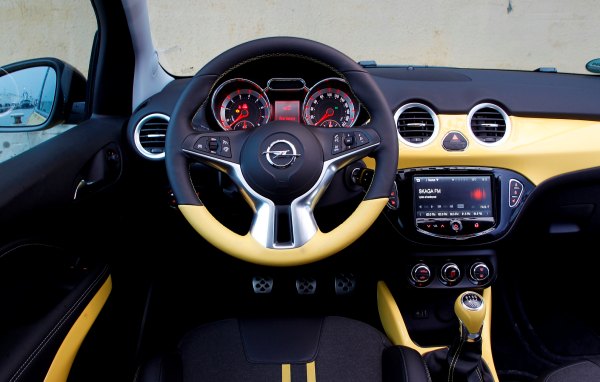
|
Inside, the Adam continues to shine with its stylish dashboard,
steering wheel and seats. The red-glowed instrument is striking. The
infotainment touch screen looks advanced. It enables sat-nav, music and
video playing through connection to your smartphone, and you can
download Apps as in Renault's R-link. Materials quality is excellent,
with lots of soft-touch plastics to overshadow even Mini and Fiat 500,
if
not Audi A1. Ergonomics is excellent, too, thanks to the minimalist
design and easy reaching controls.
The wheelbase of 2311 mm is exactly 200 mm shorter than Corsa's, no
wonder the rear seats are suitable to only children, or at best
short adults for a short trip. Nevertheless, the front occupants
enjoy plenty of comfort thanks to the car's especially wide (1807 mm)
and tall (1484 mm) stance. No so good is the boot, which swallows only
171 liters. You can fold the rear seat to expand luggage space, of
course, but the convenience of loading is seriously hampered by a step.
Even so, the Adam is not especially poor in this respect by class
standard.
Unsurprisingly, the highlight of the car is customization. You can
choose among 12 body colors, 20 wheel designs, 19 interior colors, 15
seat trims and different interior inserts, mirrors and headliners –
including an LED-lit "starry night" headliner like that you can find in
Rolls-Royce Phantom, no kidding! Should you cannot resist temptation,
you can easily double its price!
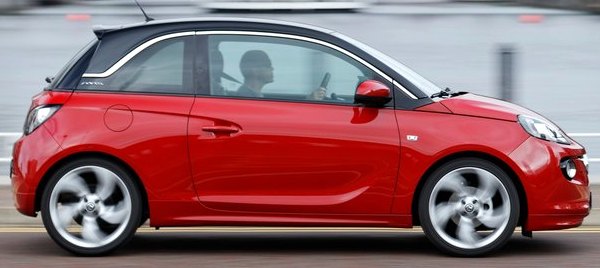
|
So far so good, but the Adam's weakest link is dynamics.
Opel promises to introduce a new 1.0-liter 3-cylinder direct injection
turbo like Ford's 1.0 Ecoboost next year, but that engine is still
under development thus the Adam has to be launched with 3 relatively
outdated engines – 1.2-liter 16V with 70 hp, 1.4-liter 16V with 87 hp
and another 1.4-liter 16V with 100 hp. Not even the 100 hp engine can
deliver a sparkling performance, partly because of its lack of low-down
torque, partly because the Adam is quite heavy – compare with a Fiat
500 TwinAir it is burdened with an extra 130 kg. I suspect its 0-60 mph
acceleration could be slower than its official figure of 10.8 seconds.
It doesn't feel that quick.
The reluctant-shifting 5-speed gearbox doesn't help either. In town,
the Adam 1.4 copes reasonably well with normal usage, but on highway it
cries for more power to overtake slower cars. Moreover, high-speed
cruising refinement is hampered by the lack of 6th gear, which forces
the engine to rev into its uncomfortable zone and make a coarse
soundtrack. This drivetrain combo is poorer than its main rivals'.
Moreover, fuel economy and emission of these outdated engines are
hardly remarkable. Even with the optional automatic stop-start feature
taken (why is it not standard?), the Adam still manages no better than
55.4 mpg and 119 g/km of CO2, hardly
numbers that you would expect on a
new car launched in 2012. Rüsselsheim had better to launch the new
three-cylinder engine as early as possible, otherwise the old engines
could ruin the reputation of Adam, by then it would be too late to save
the game.
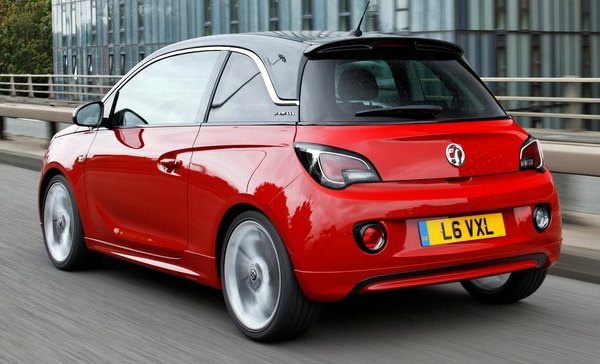
|
The dynamics problem is not just powertrain, but also the
chassis. We know its Corsa donor platform is not something to proud of,
but still we expect the ride and handling of this car could be more
polished after some adequate tuning. Yes, its ride is not quite as
bouncy as Fiat 500, but it is still stiffer and noisier than expected
for a city car. On the flip side, body roll and understeer are well
resisted. That said, the biggest problem is the electrical power
steering, which feels lifeless at the straight ahead and artificially
springy off center. In other words, it is about as communicative as a
racing car game console. Without knowing how much grip is left at the
front wheels, you can hardly get the confidence to push it on B-roads.
What a pity! The Adam is so attractive in exterior and interior
packaging. It deserves a better powertrain and chassis tuning. Over
time, I expect these problems could be sorted out. Until then, we can
only see it as an average runner in the class.
|
Verdict:    |
Published on 22
Jan 2015
|
All rights reserved.
|
|
Adam S
|
|
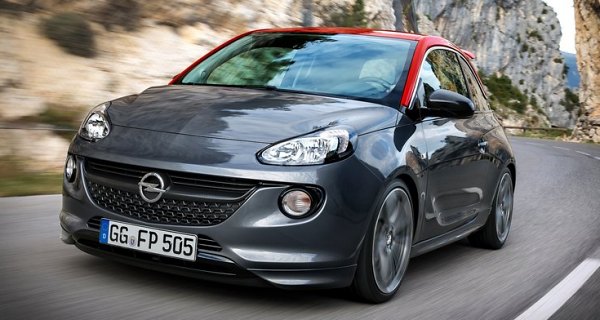
|
As I said in the original
review, Opel Adam is a very stylish and well-built city car hampered by
poor powertrains and a mediocre chassis. The new 1.0 Ecotec Turbo
three-cylinder engine launched recently has sorted half of the problems
(see new Corsa for more info about this
engine), but if you look for a
rounded dynamic package you have to turn to the latest Adam S, because
it gets not only more power but also retuned chassis for better
handling. As there won’t be an OPC model (it would have been too
expensive for a mini car), the S is set to be the hottest Adam you can
buy.
Power comes from GM’s 1.4 Ecotec turbo engine. It is not exactly a
modern design, still running port injection and cast-iron block.
However, part of the weight is offset by using hollow frame block
structure, hollow camshafts and plastic intake manifolds. The cylinder
head gets twin-variable cam phasing, while the turbocharger housing is
integrated with exhaust manifolds to save space, weight and reduce
turbo lag – again it’s hardly a new technology, as the 2001 Astra Coupe Turbo
already had this feature. This engine has been widely used within the
GM empire, including Corsa, Astra and Chevrolet Sonic RS. In this
application, its output is improved by 10 ponies to 150 hp at 5500 rpm,
while peak torque is lifted to 162 pound-foot from 2750 to 4500 rpm.
It’s not quite as responsive or flexible as modern turbo engines, which
usually start generating peak torque from 1700 rpm or so. Power is
built up linearly from mid-range, so at no time the Adam S feels like a
rocket. Using our usual phrase, it feels brisk rather than fast. This
observation matches the official 0-60 mph time of 8 seconds.
Subjectively, the 1.4 Ecotec turbo does not deserve a place in the hot
hatch field. Its exhaust note sounds flat compared with rivals like
Fiat 500 Abarth SS or Ford Fiesta ST. Moreover, it is reluctant to rev.
You have to upshift before hitting 6000 rpm. This limits the fun you
can have. Fortunately, the new 6-speed gearbox is slicker than the
notchy 5-speeder on lesser Adams.
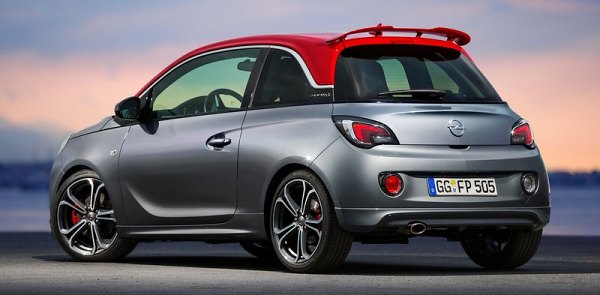
|
On the chassis side, the Adam S gets uprated springs and
dampers, thicker anti-roll bar and a stiffer torsion-beam rear axle.
Its oversized brakes come from Corsa OPC. Equally over-the-top are the
18-inch wheels and ultra-low-profile 225/35 tires. They are chosen for
looks obviously. However, the car goes well. Its ride is firm, of
course, but it also damps undulations more effectively than lesser
Adams, resulting in reasonable composure. The brakes are so powerful
that they never fade. The handling is surprisingly entertaining – don’t
get me wrong, it is not in the league of Fiesta ST, but good enough
to trouble Fiat 500 Abarth. Its wide tires offer bags of grip yet the
short-wheelbase chassis is surprisingly agile and adjustable. It
encourages you to push it to the limit into corners. There is good
front-end grip and balance to resist understeer. You can even induce
drift when the surface gets rough or loose. At higher speeds, the car
displays better stability than its short wheelbase suggested, thanks to
the downforce generated by its roof-mounted rear spoiler. The only weak
point is the electrical power steering, which delivers little feedback
but too much artificial self-centering.
Thanks to that rear spoiler and 5-spoke alloys, the Adam S is a
tasteful design. Its tall and short stance might be cartoonish
beside Fiesta ST, but its elegant finish has unparalleled showroom
appeal. Its interior is equally classy, especially if you opt for the
Recaro bucket seats. Nevertheless, so equipped it will be easily more
expensive than the Fiesta ST, which is not only a class larger but also
a lot faster and even more engaging to drive. The little Opel needs a
better
engine and steering to be a really great hot hatch.
|
Verdict:     |
|
|
|
|
|
|
|
|
|
|
Adam 1.4
|
2012
|
| Front-engined,
FWD |
| Steel monocoque |
| Mainly steel |
| 3698 / 1807 / 1484 mm |
| 2311 mm |
Inline-4
|
| 1398 cc |
DOHC 16 valves, VVT
|
| - |
| - |
| 100 hp |
| 96 lbft |
| 5-speed manual |
F: strut
R: torsion-beam
|
| - |
| 185/60R15 |
1045 kg
|
| 115 mph (c) |
10.8 (est)
|
| - |
|
Adam 1.0 Turbo
|
2014
|
| Front-engined,
FWD |
| Steel monocoque |
| Mainly steel |
| 3698 / 1807 / 1484 mm |
| 2311 mm |
Inline-3
|
| 999 cc |
DOHC 12 valves, DVVT
|
| Turbo |
| DI |
| 115 hp |
| 125 lbft |
| 6-speed manual |
F: strut
R: torsion-beam
|
| - |
| 215/45R17 |
1081 kg
|
| 122 mph (c) |
9.3 (c)
|
| - |
|
Adam S
|
2015
|
| Front-engined,
FWD |
| Steel monocoque |
| Mainly steel |
| 3698 / 1807 / 1484 mm |
| 2311 mm |
Inline-4
|
| 1364 cc |
DOHC 16 valves, DVVT
|
| Turbo |
| - |
| 150 hp |
| 162 lbft |
| 6-speed manual |
F: strut
R: torsion-beam
|
| - |
| 225/35R18 |
1103 kg
|
| 124 mph (c) |
8.0 (c)
|
| - |
|
|
|
|
|
Performance
tested by: -
|
|
|
|
|
|
|
|
|
Copyright©
1997-2015
by Mark Wan @ AutoZine
|
|